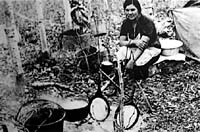In North America, Indian peoples in the east were the first agricultural
producers. They raised crops such as corn (maize), beans and pumpkins
to feed themselves. Their agricultural endeavours helped to maintain
their economic life and to encourage the growth of their culture
for hundreds of years before the arrival of the European settlers.
Indian agricultural understanding and ecological knowledge was
shown by choosing crops that were suited to the climate.

These crops helped feed the European settlers who came to North
America in the 17th century. The early settlers began farming
in Lower Canada and introduced European varieties of grains. During
the 19th century farming activity spread westward from eastern
Canada and northward from the United States.
The settlers who used European farming methods learned from the
Indian and Métis peoples. In eastern North America they
learned a method of clearing fields by removing a ring of bark
from the trees, or girdling them. The trees died, allowing the
sun to reach the land. The Indian peoples then farmed the area
for a few years before moving on and allowing the forest to return.
However, the settlers stayed in one area and used the trees as
firewood. When the stumps and roots rotted after a few generations,
they had open fields to seed. Settlers also cleared the land by
manually removing the trees and stumps.
Indian and Métis peoples also shared their method of planting
crops with the early settlers. In Europe, it was common to sow
the seed by broadcasting it. Indian peoples carefully chose and
planted the seed. They were very aware of practical genetics. For example, Indian farmers fertilized each corn plant by putting corn pollen on its silk. They discovered that taking the pollen from one variety and placing it on another variety produced a new variety of corn. Today, this process is called hybridization.
Western Canada was first known for its rich furs, drawing explorers
and fur traders to the prairie and forest regions. Early Indian
peoples in the area now called Saskatchewan, were basically hunters
and gatherers. Little agricultural activity occurred in the West
because of the hunting and gathering lifestyle of the Indian peoples.
Settlement by nonAboriginal immigrants began in the parkland area of Saskatchewan, although a few ranches existed in the southwest
in the 1880s.
The construction of the railroad through the south
in the mid 1880s encouraged more settlers to homestead in that
area, but did not increase the speed with which settlement was
occurring. On the open grasslands of western Canada, the pioneers did not
need to be as concerned about clearing the land. | 